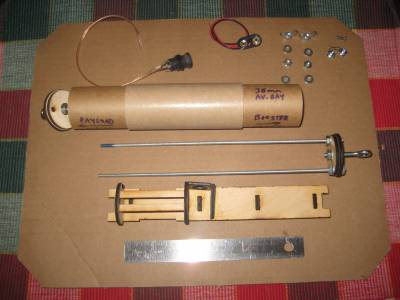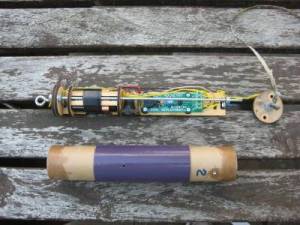Kookaburra - scratch built 38mm dual deploy rocket
By Gene Wolski
2012-03-14
I had already converted my 4" BSD Horizon for dual deployment and successfully flew it for my Level 2 certification. I wanted to build a smaller diameter dual deployment rocket that could fly on G motors, so I fired up RockSim and started designing. I chose 38mm since I had most of the components on hand except for the altimeter bay. Fortunately, K&S released a 38mm altimeter bay kit that looked perfect for the job. I really like PML's G10 fins, so I chose one of their stock fins for this design. By this time, the complete design had come together.

Avionics Bay
2012-03-14
The real key to this project was the avionics bay from K&S. I'd already scratch built several avionics bays, and I was not looking forward to building a 38mm bay. When K&S released their avionics bay kit, this project jumped into high gear! Below is a picture of the partially assembled kit. Sharp eyes will note the switch plate is not assembled correctly. I was able to separate the parts and re-attach them in the correct position.

Component Listing
2012-03-15
- LOC 38mm nose cone
- Stainless steel eyebolt (3/16")
- LOC 38mm airframe (payload section)
- K&S 38mm avionics bay (includes switch and 9v battery connector)
- LOC 38mm airframe (booster section)
- LOC 29mm motor tube
- LOC 29mm-38mm centering rings
- GLR 29mm ogive tailcone retainer
- PML G10 fins (style #A-05)
- LOC small rail buttons
- 1/8" kevlar shock cord
- Adept22 altimeter
- 4-40 PEM nuts and low profile screws
- Two conductor wire leads (scrounged from expended ematches)
Completed Avionics Bay
2012-03-15
Here's the completed avionics bay with battery, switch, and altimeter installed. It may not be obvious from the the photo, but I enlarged one of the static vents slightly to allow a slim screwdriver to be used to turn the switch on & off. Also clearly visible (near the #2 in blue Sharpie) is one of the PEM nuts used to attach the payload section to the upper end of the avionics bay. I used neoprene washers from Missile Works as standoffs for the Adept22. The washers provide enough clearance so the altimeter doesn't bottom out on the sled. With the Adept22, you do need to pay attention closely to the wiring diagram.

I also used sections of used ematch leads for the ejection charge leads. I also soaked the ends of the avionics bay with CA to harden them slightly. The required only light sanding to fit back into the airframe tubes.
Booster section
2012-03-16
I started with the booster section by dry fitting the motor tube, centering rings, fins, and tailcone retainer. Once I validated the spacing, I marked (using a fin marking guide printed from VCP) and cut the fin slots using a fresh #11 hobby blade and a metal straight edge. I performed one more dry fit to validate that everything lined up properly. I epoxied the shock cord to the motor tube along with the centering rings. I attached the tailcone retainer to the motor tube using JB Weld. I then pulled the shock cord back through the motor tube and epoxied the whole assembly into the booster section.
With the motor mount assembly completed, I buttered the edge of a fin with epoxy and inserted it into a slot. I repeated this for each fin before applying the external fillets. With the fins completed, I drilled holes for the rail buttons and installed them. The booster section was now complete.

Nose cone & finishing
2012-03-16
Last but not least, I cut a small hole in the nose cone shoulder and dropped in a 3/16" nut which I used to secure the eyebolt. I added a couple of drips of epoxy into the hole to secure the nut. Once assembly was complete, I painted the rocket using Krylon gray primer followed by two coats of Krylon purple. I left the tailcone unpainted, and I painted the nose cone using Krylon metallic bronze. I applied two coats of Krylon clear once the paint had dried for several days.

Sponsored Ads
 |
 |
















